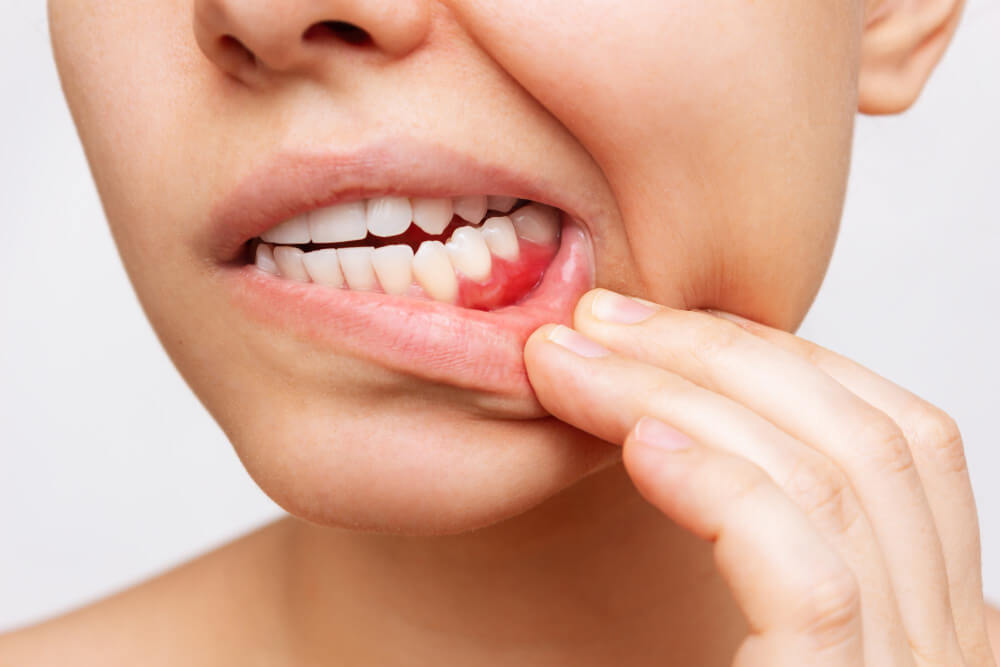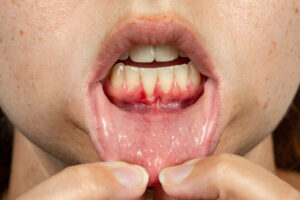Is gum disease contagious?

Gum disease, a common concern affecting millions worldwide, raises an important question: is periodontal disease contagious??
This article delves into the heart of the matter, exploring the intricacies of gum disease, its transmission, and the expert opinions surrounding its contagious nature.
We’ll guide you through the latest research, prevention strategies, and the steps you can take to protect yourself and your loved ones.
Table of Contents
Is gum disease contagious?
Gum disease is influenced by the transfer of harmful bacteria through saliva, occurring during activities like kissing or sharing utensils. However, whether someone develops gum disease depends on their oral hygiene, genetic susceptibility, lifestyle choices, and immune system strength, rather than just exposure to these bacteria.
Maintaining good oral health practices and regular dental visits are essential in preventing the onset and progression of gum disease, highlighting that while bacteria can be shared, the disease’s development is multifactorial and not directly contagious like common viral or bacterial infections.
Can gum disease be spread by kissing or sharing saliva?
Gum disease is primarily caused by the buildup of plaque, a sticky film of bacteria that forms on teeth. The bacteria that contribute to gum disease and tooth decay can be transmitted through saliva, meaning that it is theoretically possible to spread these bacteria to someone else through activities that involve the exchange of saliva, such as kissing or sharing utensils, cups, or toothbrushes.
However, the risk of developing gum disease is more complex than simply being exposed to these bacteria. Factors that determine whether a person will develop gum disease include:
- Oral hygiene habits: Regular brushing, flossing, and dental check-ups can significantly reduce the risk of gum disease, regardless of exposure to bacteria.
- Immune system response: Individuals react differently to the presence of harmful bacteria in their mouths. Some people may be more genetically predisposed to developing gum disease than others.
- Lifestyle factors: Smoking, poor diet, and stress, among other factors, can increase the risk of developing gum disease.
While it’s possible to transmit bacteria associated with gum disease through saliva, maintaining good oral hygiene and a healthy lifestyle are key factors in preventing the onset and progression of gum disease.
To minimize the risk of transmission and development of oral health issues, it’s important to practice good oral hygiene, eat a balanced diet, avoid smoking, and visit the dentist regularly for check-ups and cleanings.
How does gum disease spread?
Gum disease spreads primarily within an individual’s mouth through the accumulation of plaque, a sticky film of bacteria that forms on teeth and gums.
If not removed by regular brushing and flossing, plaque can harden into tartar, exacerbating gum inflammation and leading to periodontitis, a more severe form of gum disease.
What is gum disease?
Gum disease, also known as periodontal disease, is a common but preventable condition that affects the gums and the bone that supports the teeth.
It ranges from simple gum inflammation, known as gingivitis, to more severe forms like periodontitis, which can lead to tooth loss.
Caused primarily by the buildup of plaque, a sticky film of bacteria on teeth, gum disease can progress silently, often without pain.
What are the symptoms of gum disease?
Gum disease, also known as periodontal disease, progresses through several stages, from gingivitis to advanced periodontitis, with symptoms intensifying as the disease advances.
Here are the symptoms of gum disease at various stages:
Early Stage: Gingivitis
- Red, swollen gums: The gums may appear more reddish than their normal pink and can feel tender.
- Bleeding gums: This often occurs during brushing or flossing.
- Bad breath: Persistent bad breath or a bad taste in the mouth can be an early sign.
- Receding gums: Gums may begin to pull away from the teeth slightly.
Moderate Stage: Periodontitis
- Increased inflammation and bleeding: Gums become more irritated, inflamed, and bleed more easily.
- Gum recession: Gums may recede further, making the teeth look longer.
- Pockets formation: Spaces or pockets develop between the teeth and gums, trapping food and plaque.
- Sensitivity: Teeth may become more sensitive to temperature and touch.
Advanced Stage: Advanced Periodontitis
- Loose teeth: As the disease progresses, the bones and fibers that hold teeth in place are destroyed, leading to loose teeth or tooth loss.
- Change in bite: Changes in the way teeth fit together when biting or in the fit of partial dentures.
- Abscesses: Infections may occur under the gums and in the bone, leading to abscesses.
- Severe bad breath and taste: Due to decay and infections.
If you experience any of these symptoms, see a dentist or periodontist for an evaluation and treatment to prevent further damage and potentially save your teeth.
Early intervention can often reverse the effects of gingivitis, the only stage of gum disease that is reversible.
How to prevent gum disease
Preventing gum disease involves a combination of good oral hygiene practices, regular dental checkups, and healthy lifestyle choices.
Here are key strategies to help prevent periodontal disease:
Maintain Good Oral Hygiene
- Brush your teeth at least twice a day with fluoride toothpaste. Use a soft-bristled toothbrush and replace it every three to four months, or sooner if the bristles are frayed.
- Floss daily to remove plaque from areas your toothbrush can’t reach. It’s crucial for cleaning between the teeth and under the gumline.
- Use mouthwash to help reduce plaque and remove remaining food particles that brushing and flossing missed.
Regular Dental Visits
- Schedule regular dental checkups and cleanings at least twice a year, or as recommended by your dentist. Professional cleanings are essential for removing tartar (hardened plaque) that can’t be removed by brushing and flossing alone.
- Discuss any changes in your oral health with your dentist, including any recent illnesses or ongoing conditions.
Healthy Lifestyle Choices
- Quit smoking. Smoking is a significant risk factor for gum disease. Quitting can help reduce your risk.
- Eat a balanced diet. Nutrient-rich foods from all the food groups promote healthy teeth and gums. Vitamin C and calcium, in particular, support gum health.
- Limit sugary snacks and drinks. Consuming too many sugary foods and beverages can promote plaque formation.
- Stay hydrated. Drinking plenty of water helps keep your mouth clean and encourages saliva production, which can help protect against gum disease.
Monitor Changes and Respond Quickly
- Watch for signs of gum disease, such as redness, swelling, bleeding, bad breath, and loose teeth. Early detection and treatment can prevent serious complications.
- Manage stress. High levels of stress can affect your ability to maintain good oral hygiene practices and can also affect your immune system’s response to fighting off bacteria that cause gum infections.
Consider Dental Advances
- Use therapeutic mouth rinses and toothpastes if recommended by your dentist. Some products are specifically designed to fight gingivitis or control plaque.
- Consider dental sealants. Ask your dentist if sealants could help protect your teeth from decay, as this can indirectly help prevent gum disease.
By adopting these practices, you can significantly reduce your risk of developing gum disease and maintain a healthy mouth.
FAQ on Is gum disease contagious
Can kids get gum disease?
Yes, children can develop gum disease, although it typically appears in a milder form known as gingivitis, characterized by red, swollen gums that may bleed during brushing. Good oral hygiene habits, including regular brushing and flossing, are crucial in preventing its occurrence. While more severe forms of gum disease
Are diabetes and periodontal disease related?
Diabetes and periodontal (gum) disease have a bidirectional relationship, where diabetes increases the risk of developing gum disease due to higher glucose levels in saliva and a weakened immune system. Conversely, severe gum disease can worsen blood glucose control, complicating diabetes management. Effective management of one condition can positively impact the control of the other. For individuals with diabetes, maintaining good oral hygiene, attending regular dental checkups, and controlling blood sugar levels are essential steps to prevent gum disease and manage diabetes more effectively.
Fact Checked
Our dedicated team rigorously evaluates every article and guide to ensure the information is factual, up-to-date, and free of bias.
Updated Regularly
We update our articles and reviews regularly to ensure you have access to the latest data in the dental industry.
The content on Dental3DU’s blog is intended for educational purposes only. This information should not be relied upon as professional medical counsel. Be sure to always consult with your dentist about the dangers and benefits of any medication, treatment or procedure.







